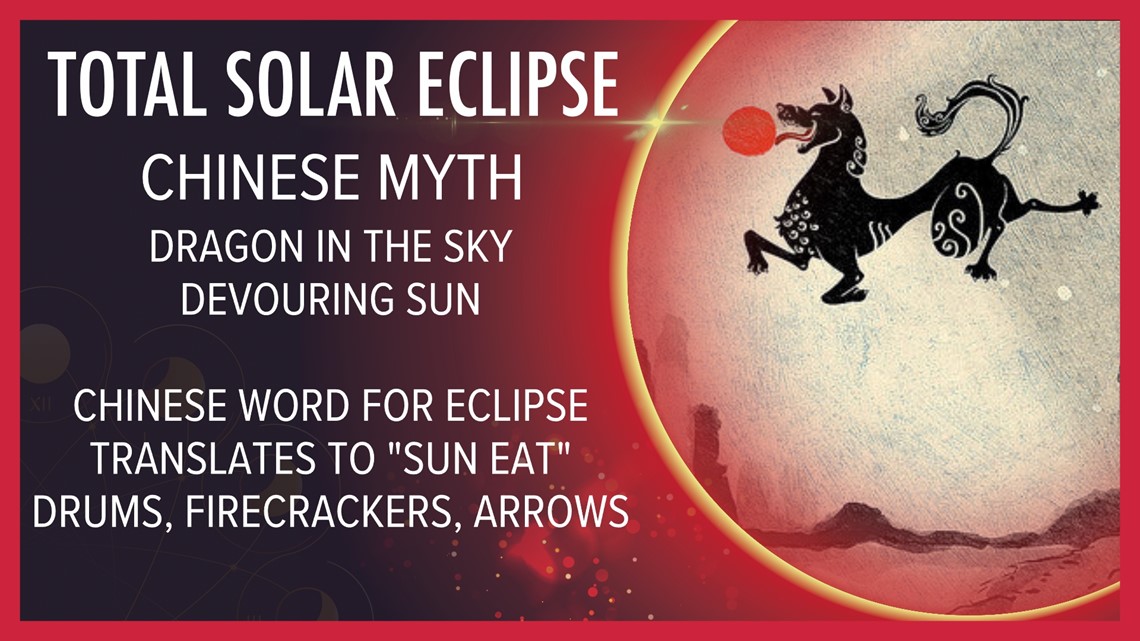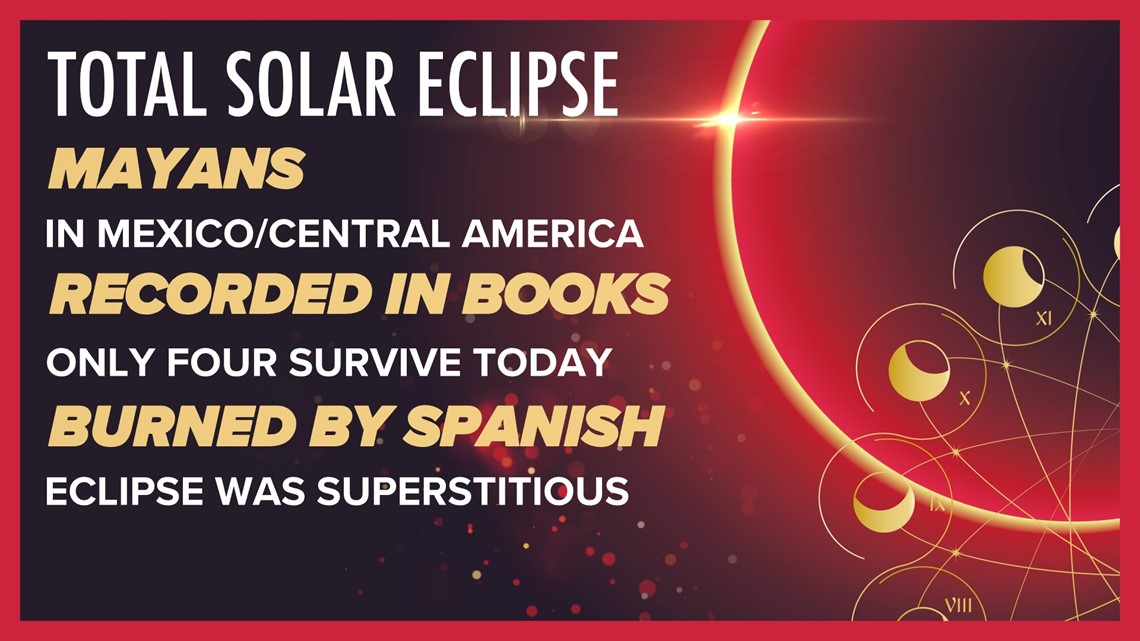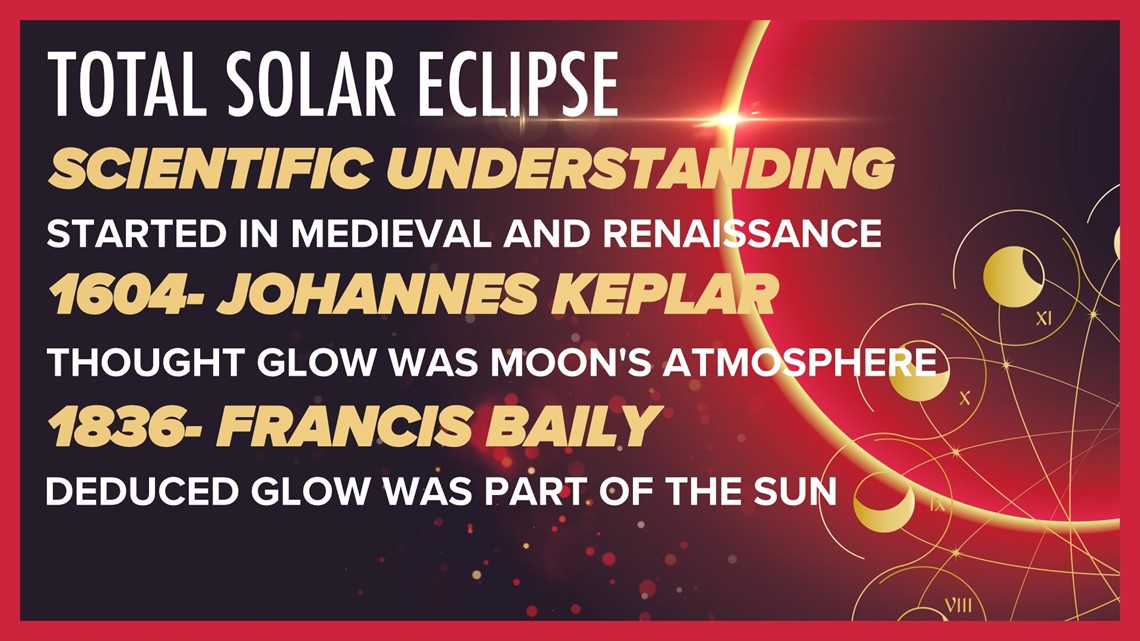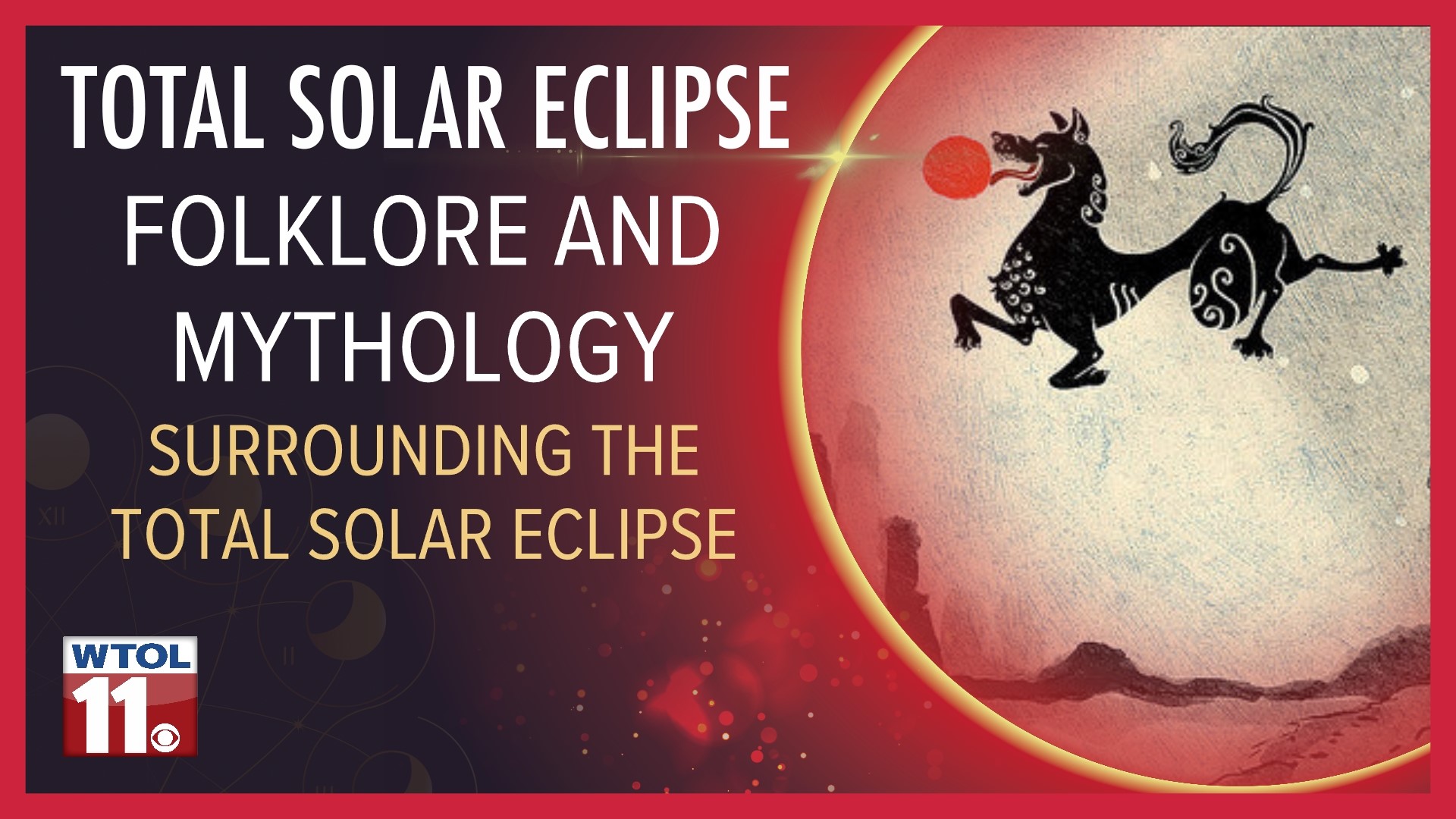TOLEDO, Ohio — Solar eclipses have fascinated humans for millennia, inspiring various religious, superstitious, and scientific explanations. While we now know that the darkness during a total solar eclipse is caused by the moon passing in between Earth and the sun, early civilizations lacked this modern scientific understanding, employing folklore and mythology instead.
Solar eclipses have been documented for thousands of years, and the earliest mentions date back to 2159 B.C. Four thousand years ago, Chinese astronomers observed eclipses and attempted to predict their future occurrence. While Chinese stargazers speculated future astronomical events, they did not understand why they occurred.
Early Chinese mythology postulated that a celestial dragon in the sky gobbled up the sun during total solar eclipses. In an effort to scare the dragon and restore sunshine, the Chinese traditionally banged on drums and made loud noises to frighten the serpent.


Additional remedies for eclipses included shooting arrows into the sky and igniting fireworks. Chinese folklore surrounding eclipses continued for centuries, and inscribed animal bone artifacts dating back to 772 B.C. show written records of eclipses.
In other parts of the world, cultures from this era recorded, explained and predicted eclipses using similar mythology and primitive science. Babylonian stargazers attempted to predict the eclipse as early as 750 B.C. Generations of eclipse observations provided data to make future speculations. Using a formula of adding 18 years and 11 and three quarter days, Babylonians predicted future occurrences of eclipses fairly successfully even by modern scientific standards.
Across the Atlantic Ocean, Mayan astronomers observed and predicted eclipses. Residing in Mexico and Central American since 2000 B.C., Mayans noted the regular intervals in between eclipses, expecting some degree of predictability of future eclipses. While Mayans observed solar eclipses with fascination, they failed to understand the scientific cause of totality. Mayans explained eclipses as the wrath of the sun god, who could be appeased with ritualistic sacrifices.
In an effort to restore balance to the cosmos and bring back sunny weather, the Mayans employed a similar tactic to the Chinese: music and dance. Banging on drums and performing ceremonial dances during the darkness of total solar eclipses were believed to awaken the sun from its slumber.


While Mayans documented eclipses for centuries, most of these records were burned by Spanish conquistadors in fires. The Spanish viewed the Mayan eclipse explanations as paganistic and in direct contradiction to their Catholic doctrines, erasing many of these records. Several books of Mayan eclipse records survived the test of time.
In the Americas, many indigenous tribes employed similar mythology to explain solar eclipses. While most tribes believed some sort of god or demon was attempting to swallow the sun during totality, each group posited a slight variation of the myth.
EVERYTHING YOU NEED TO KNOW: Total solar eclipse 2024 guide
The Choctaw tribe, for example, believed a black squirrel tried to swallow the sun during eclipses. Just like the Chinese dragon and the Mayan sun god, the squirrel was apparently frightened by loud noises; the Choctaw used music in an effort to drive away the evil spirit.
The Cherokee tribe attributed eclipses to a frog in the sky trying to swallow the sun. Similarly, loud music from rattles, drums, and gongs was viewed as an effective remedy to the darkness of totality. Many indigenous cultures believed eclipses were dangerous, particularly to children and expecting women, and attempted to hide the vulnerable population from the darkness.


In summary, most early mythology surrounding eclipses utilized similar storytelling and characters with slight variations. While early cultures did a decent job predicting the future occurrence of eclipses based on past observations, they failed to understand the scientific cause of totality.
Modern scientific understanding of eclipses began during the Medieval and Renaissance periods. Early researchers posited various explanations for the sun's corona, or outermost layer of its atmosphere that glows during totality. In the early 1600s, German astronomer and mathematician Johannes Kepler speculated that the glow around the sun during eclipses was the moon's atmosphere, illuminated by the sun's rays.
A couple centuries later, British astronomer Francis Baily correctly discovered that the glow was not part of the moon, but rather an appendage of the sun's atmosphere. During the annular solar eclipse of May, 1836, Baily observed irregularly shaped glowing dots caused by sunlight reflecting off the rugged and uneven terrain of the moon. Termed "Baily's beads", this optical phenomenon will be visible on April 8 with protective eclipse glasses. Baily's eclipse observations paved the way for modern scientific understanding.
In the early 20th century, Albert Einstein's general theory of relativity explained the bending, or refraction, of light as it passed through the gravitational field of the sun. Published in 1915, Einstein's theory was difficult to visualize and test in a laboratory setting.
Four years later during a 1919 solar eclipse, astronomers studied the apparent positions of various stars before and during totality, determining that the relative position changed due to the bending of light in the gravitational field of the sun's atmosphere. With over six minutes of totality, this historically long-lasting solar eclipse provided English astronomers Arthur Eddington and Frank Dyson with the opportunity to study Einstein's theory.


After the 1919 eclipse, Albert Einstein became a household name and his theory shaped our modern understanding of the universe. Over a century later, scientists are still studying eclipses, and the April 8 total solar ellipse will inevitably provide both intrigue and information for researchers.
Humans have observed, researched, and explained solar eclipses for over four thousand years. Early civilizations posed supernatural explanations without any scientific basis. Even with modern science, the amazing spectacle of solar eclipses still dazzles audiences around the world. Stay tuned as the WTOL 11 weather team prepares you for the total solar eclipse on April 8.
PLAYLIST: WATCH MORE TOTAL SOLAR ECLIPSE COVERAGE FROM WTOL 11

